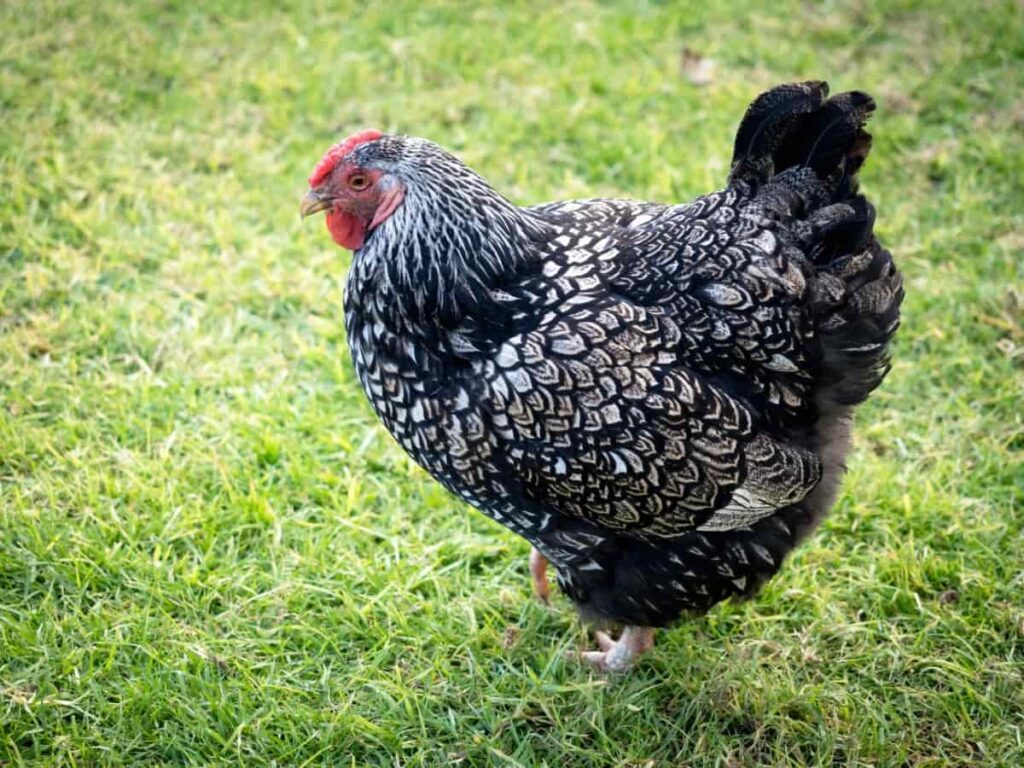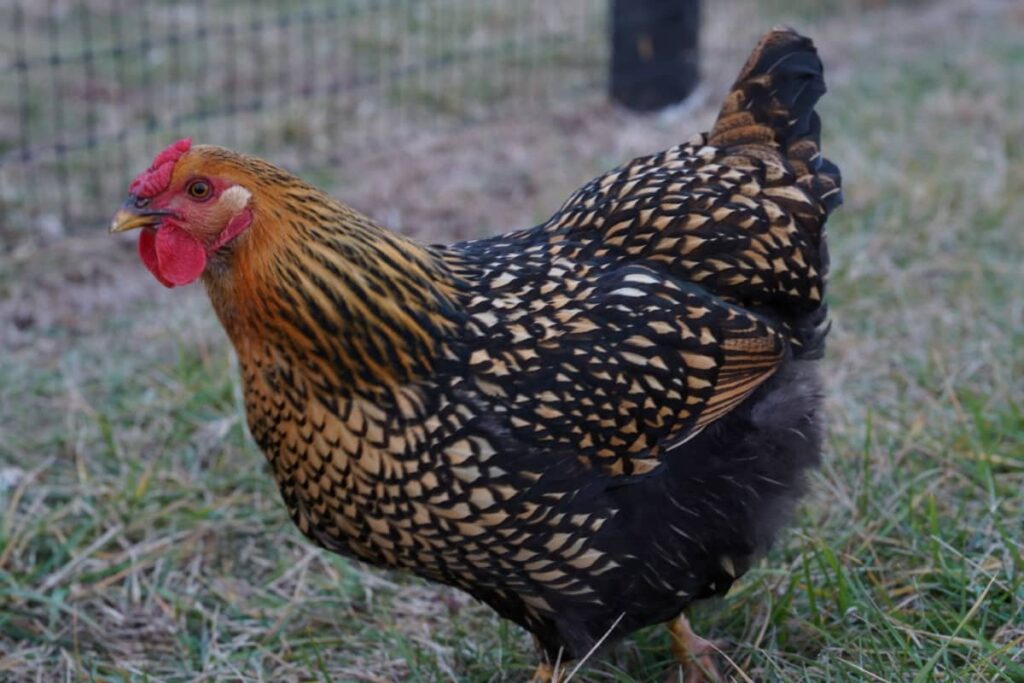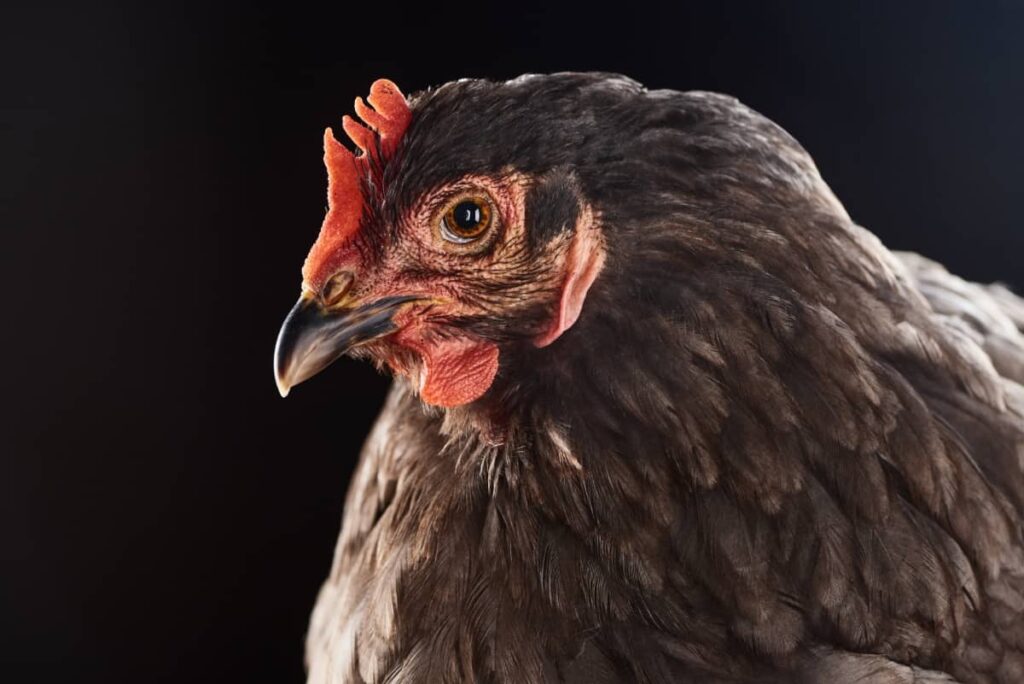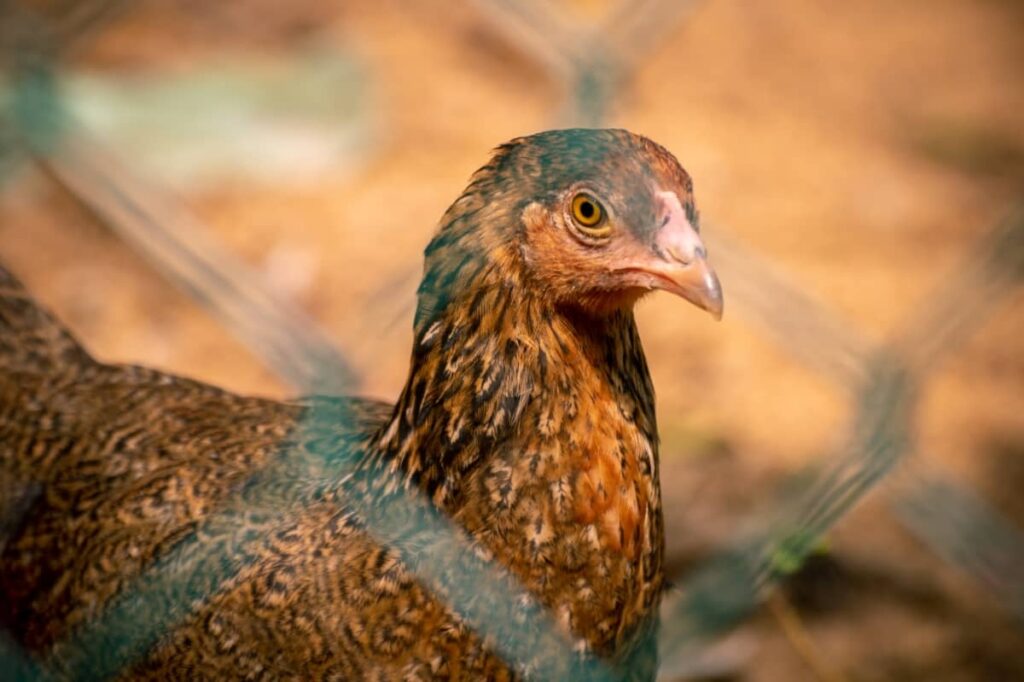The Wyandotte chicken breed originated in the United States in the 19th century. Named after the Wyandot Native American tribe, it was developed by crossing various breeds, including the Silver Sebright, Cochins, and Hamburgs.
Characteristics and Traits of Wyandotte Chicken
Wyandottes are renowned for their striking appearance, characterized by a rose comb, clean legs, and a compact, rounded body. They come in various color varieties, including silver, gold, and blue laced. Known for their docile and adaptability to different climates, Wyandottes are excellent foragers and do well in free-range environments.
Importance in Backyard Poultry
Their dual-purpose nature makes them valuable for both meat and egg production. Also, their gentle disposition makes them suitable for families and beginners. Their cold hardiness makes them adaptable to diverse climates, while their attractive appearance adds aesthetic value to backyard flocks.
Wyandotte Chicken Varieties
Silver Laced Wyandotte
Description and Characteristics: The Silver Laced Wyandotte is a striking breed known for its distinctive black and white feather pattern resembling intricate lacing. They boast a compact, sturdy build with rose combs and yellow legs. Hens lay brown eggs. They’re cold-hardy and adaptable to various climates.
Historical Significance: The Silver Laced Wyandotte holds a significant place in American poultry history. Developed in the late 19th century, they were bred in New York State by crossing Silver Spangled Hamburgs, Dark Brahmas, and Partridge Cochins.

Golden Laced Wyandotte
Description and Characteristics: They feature a striking golden color pattern with black lacing around each feather, giving them a regal appearance. These chickens are dual-purpose, making them a favorite among backyard enthusiasts and small-scale farmers.
Breeding for Color: Breeders should focus on selecting birds with strong golden base coloration and crisp, distinct black lacing. This involves careful pairing of individuals with desirable color traits to produce offspring that closely adhere to the breed standard.
In case you missed it: How to Raise Frizzle Chickens: A Comprehensive Guide for Beginners

Buff Wyandotte Chickens
Unique Features: Buff Wyandotte chickens are prized for their stunning appearance and docile temperament. Unique features include their golden buff plumage and distinctive rose combs.
Care and Maintenance: Care involves providing a spacious coop, regular feeding of high-quality poultry feed, and access to fresh water. Maintenance includes monitoring for signs of illness, routine cleaning of the coop, and regular health check-ups.
Black Wyandotte Breed
Appearance and Personality Traits: The Black Wyandotte is a striking breed with glossy black plumage, a rose comb, and yellow legs. Their feathers exhibit a greenish sheen under sunlight, adding to their allure. Black Wyandottes are known for their docile and friendly nature. They tend to be calm, easygoing birds.
Tips for Raising: Provide ample space for Black Wyandottes to roam and explore as they enjoy free-ranging. Ensure a balanced diet rich in protein, vitamins, and minerals to support their health and egg production. Keep their coop clean and well-ventilated, and provide nesting boxes for egg-laying. Regular health checks and predator-proofing are essential for their safety and well-being.
In case you missed it: Dong Tao Chicken Breed: Origin, History, Appearance, Size, Characteristics, Eggs, Price, and Lifespan

Rare Wyandotte Varieties
Blue Laced Red Wyandotte
Genetic Makeup and Appearance: They possess a genetic makeup that includes the blue gene for lacing and the red gene for their base color. Their feathers exhibit a beautiful combination of red and blue, with intricate lacing patterns, making them highly sought after in poultry breeding communities.
Challenges in Breeding: Maintaining the desired coloration and lacing patterns while avoiding undesirable traits can be complex. Inbreeding depression, where genetic defects become more prevalent in successive generations, is also a concern.
Partridge Wyandotte
Color Patterns and Identification: Partridge Wyandottes are characterized by their rich mahogany base color, with distinct black lacing around each feather. Their breast, fluff, and abdomen are a deep reddish-brown, while their feathers display a glossy greenish-black.
Habitat and Rearing Tips: Provide Partridge Wyandottes with a spacious coop to roam and forage. Ensure the coop is well-ventilated and predator-proof. A balanced diet of high-quality poultry feed supplemented with greens and protein sources like mealworms or legumes is essential for their health.
In case you missed it: Vorwerk Chicken Breed: History, Origin, Characteristics, Price and Egg Production

Silver Penciled Wyandotte
Distinctive Markings and Beauty: The Silver Penciled Wyandotte is adorned with striking silver and black markings, creating a captivating appearance. Their intricate penciled plumage and rose comb add to their beauty, making them popular among poultry enthusiasts.
Ideal Conditions for Health and Growth: Provide Silver Penciled Wyandottes with a balanced diet rich in nutrients, ample space for exercise, and a clean living environment. Regular health checks, access to fresh water, and protection from harsh weather conditions are essential for their well-being.
Wyandotte Bantam Chickens
Overview of Bantam Varieties: Wyandottes are a popular breed in both standard and bantam sizes. They are known for their rounded shape, rose comb, and dense feathering, making them attractive for exhibition and backyard flocks alike.
Popular Bantam Colors: Popular bantam colors include Silver Laced, Golden Laced, Blue Laced Red, Buff, Black, White, Columbian, and Partridge. Each color variety has its unique charm and appeal, contributing to the diversity of Wyandotte bantams.
Comparing Bantam to Standard Sizes :Bantam Wyandottes are smaller in size compared to their standard counterparts. Bantams typically weigh around 450 grams to 900 grams, while standard Wyandottes can weigh between 3.6 to 4 kg. Despite their smaller size, bantam Wyandottes maintain the same distinctive appearance and characteristics as standard Wyandottes.
Special Considerations for Care: Provide them with adequate space, nutrition, and protection. Due to their compact size, they may require additional protection from predators. A balanced diet rich in nutrients and providing regular health checks can help maintain their well-being.
Show Quality and Ornamental Wyandottes
Preparing Wyandottes for Poultry Shows: Preparing Wyandottes for exhibition involves meticulous grooming and attention to detail. Bathing, trimming feathers and conditioning plumage are essential. Proper diet and health maintenance ensure vibrant colors and optimal presentation.
Judging Criteria: Color and Pattern: Judges assess Wyandottes based on adherence to breed standards, emphasizing uniformity, clarity, and richness of color. Balanced patterns, crisp lacing, and absence of defects are prized qualities. Attention to detail in breeding and selection is crucial for achieving desired traits.
Ornamental Uses in Homesteads and Gardens: Wyandottes, with their striking appearance and docile temperament, add aesthetic value to homesteads and gardens. Their vibrant plumage and regal carriage make them attractive features in ornamental flocks.
Breeding Colorful Wyandotte Chickens
Basic Genetics of Feather Coloring: Understanding the genetic basis of feather coloring in Wyandotte chickens is essential for effective breeding. Traits like lacing, penciling, and ground color are influenced by multiple genes, with interactions that determine the final phenotype.
Techniques for Selective Breeding: Selective breeding involves carefully choosing breeding pairs based on desired traits, such as specific color patterns and intensity. Utilizing pedigree analysis, phenotype evaluation, and controlled mating strategies can help enhance color variations within the Wyandotte breed.
Ethical Considerations in Breeding Practices: Ethical breeding practices prioritize the welfare of the birds, avoiding harmful genetic defects and promoting overall health. Breeders should strive for genetic diversity, avoid excessive inbreeding, and ensure adequate housing and care for all birds involved. Transparency in breeding practices, including honest representation of the birds’ health and genetic backgrounds, is essential for maintaining trust within the poultry community.
Egg Production in Different Wyandotte Chickens
| Wyandotte Chicken Varieties | Average Egg Production per Year |
| Silver Laced | 180-220 eggs |
| Golden Laced | 200-240 eggs |
| Blue Laced Red | 190-230 eggs |
| Black | 180-220 eggs |
| White | 200-240 eggs |
| Buff | 190-230 eggs |
Note: The images presented in this post are intended solely for representation purposes. The images are meant to serve as visual aids and should not be relied upon as accurate representations of their real-life counterparts.
Conclusion
These are just a few of the many varieties of Wyandotte chickens available. Each chicken variety has its unique characteristics and appeal, making Wyandottes a popular choice for poultry enthusiasts and Backyard Wyandotte chickens keepers alike.
- Management Pests and Diseases in Your Cotton Field
- Sheep Farming Business Plan for Beginners
- Aquaponic Farming at Home: A Step-By-Step Guide
- Profitable Village Farming Business Ideas in 2024
- High-Yield Aquaculture: Fast-Growing Fish for Farming
- Effective Fish Pond Construction Techniques for Beginners
- Irrigation and Water Management in Pineapple Farming
- Blossom to Harvest: Mastering Flowering and Pollination in Papaya Farming
- Pig Fattening Essentials: From Selection to Sale for Beginners
